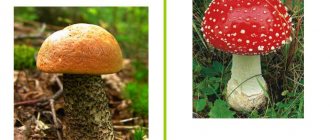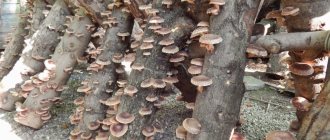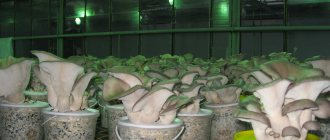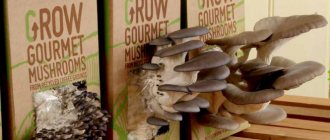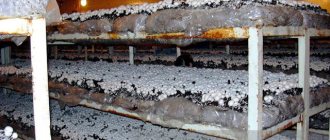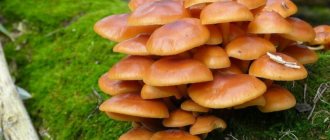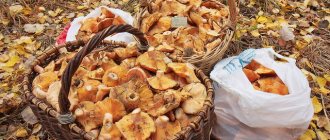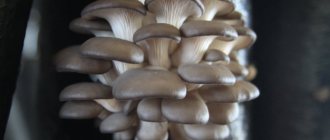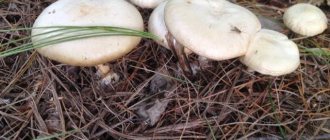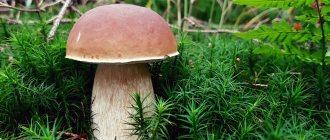- Reports and messages
- Mushrooms
- Growing mushrooms
Today mushrooms are a very popular food product.
You can prepare a wide variety of dishes from them: soups, sauces, salads, and mushrooms can also be pickled or pickled. Mushrooms can be collected in the forest, or you can buy them in a store. But recently, growing mushrooms has become very popular not only in summer cottages, but also at home. The easiest to grow on your own are oyster mushrooms and champignons. To grow mushrooms at home, you need to choose a clean, dry and well-ventilated place. And also take care of constant humidity within 80%. This can be achieved by installing a container of water in the room. A greenhouse is perfect for such a room. To get a good harvest, you need compost consisting of straw, sawdust, sunflower husks, gypsum and chalk. The mixed ingredients are poured with hot water and left for about 3 weeks. After preparing the room and compost, you need to purchase mycelium and plant it in the ground. Chicken or cow droppings are suitable for fertilizing the soil. And the first harvest of oyster mushrooms will be in a month.
Porcini mushrooms are best grown in summer cottages. The best period for sowing mycelium is from May to September. You can purchase ready-made mycelium in the store and plant it in a hole 25 cm deep. First, you must place the first layer of substrate in the hole, consisting of dry leaves, bark and nutrient mixtures. Then the second layer, which will consist of humus. We lay the mycelium on it, sprinkle it with a layer of nutrient mixture, and sprinkle another layer of earth on top.
Or make your own solution with mushroom spores. The solution is prepared as follows: soak the porcini mushroom cap in cold water for 24 hours. This solution is used to water a plot of land near trees.
Option No. 2
Many of us are very fond of culinary dishes made from mushrooms. Mushrooms give salads, soups, sauces, meat and vegetable dishes a unique taste and aroma. We are used to collecting boletuses and boletuses, russula and chanterelles in the forest or buying champignons and oyster mushrooms in the supermarket. Is it possible to grow them yourself, in the garden, at home, on the balcony? What is required for this and how to care for the mycelium to get a good harvest? Let's figure it out.
You can grow mushrooms in your dacha or garden in three different ways: by propagating them with mycelium, using mycelium, or using finely crushed mushroom caps collected in the forest.
Fans of “quiet hunting” sometimes unintentionally bring mycelium from the forest if they do not cut off the found mushroom at the base, but break it out along with the part located in the ground. In other cases, people deliberately take away a piece of the upper part of the soil from the places where they found mushrooms, hoping that in this way they will transfer the mycelium to their summer cottage. This is an extremely unreliable matter. Firstly, in order to really get a harvest, the mycelium will have to create a number of conditions: it is necessary to remove the top layer of soil from the site of the planned mushroom “bed”, lay down a layer of dry leaves, then soil. Secondly, it is important that the same trees and shrubs grow in the neighborhood that were neighbors of the mycelium in the forest. Thirdly, the place should be shady, but not windy, and the soil should be evenly moistened. Fourthly, the soil on the site should not be dug up for at least 2-3 years, so as not to damage those parts of the fungus that are underground and of significant size.
As you can see, this is a rather complicated matter; moreover, it is categorically not recommended to disrupt the vital activity of the mycelium existing in forest conditions.
A much simpler way to harvest mushrooms at home is to grow them from mycelium purchased at a specialty store. The most popular are oyster mushrooms or champignons. They are grown on linden, alder, and ash wood. For this, parts of cut trees that are well moistened are suitable; special cuts or holes are made on them, into which the mycelium is placed. At the same time, for mushrooms to grow, it is necessary to maintain a certain level of temperature and air humidity. Often such mushrooms can grow in basements. And for growing oyster mushrooms, a nutrient substrate rich in organic fertilizers can even be placed in bags suspended from the ceiling.
Another way to grow mushrooms in your summer cottage is to sow crushed wild mushroom caps into prepared soil. At the same time, part of the forest soil is added to the garden soil, and the caps are crushed using a meat grinder and soaked for a day. The resulting solution with small particles of mushrooms is watered onto the ground and sprinkled with dry leaves. Mushrooms are demanding of soil moisture. It is necessary to water with warm water using a watering can with a sprayer.
The efforts of real mushroom growers will definitely lead to good results, and within a few weeks after planting you will be able to surprise your guests with the unusual fruits of your garden.
5th, 6th grade biology
A little about growing mushrooms.
In Western society, almost five decades ago, there was only one variant of the mushroom that could be eaten, and that was the White Button Shield, also known as Agaricus bisporus. This type of mushroom can be cultivated with straw and manure compost.
In contrast, in the east, various types of mushrooms were grown in the 70s. People of Eastern cultures cultivated a series of tree mushrooms that were actually grown using wooden trunks. Such species include Curtis Singer Flammulin velutipes, Enoke of Auricularia polytricha Mont. Sacc., Wooden ear and edodes lentinuales.
During the 19th century, little was known about the spores or growth of mushrooms, and this lack of understanding had a major impact on how mushrooms were actually grown during this time. For example, a grower would have to go out and collect the bodies of the mushrooms, removing them from their natural habitat. The fungi were then placed on a new type of substrate, and the spores in turn colonized the selected substrate to grow more fruiting bodies of the selected fungi.
Even today, many types of mushrooms cannot be grown simply because you cannot determine how mushrooms work. We know that they begin as dust-sized spores that are released from the pores or gills below the fungal tips of the adults. We also know that the fungus will remain in the mycelium stage for most of its life. Here the room is part of a network of wettable fibers containing wood and permeating organic enzymes.
Nowadays, in both Eastern and Western societies, there are many more species that you can safely grow than ever before. But of the 14,000 species of mushrooms, approximately 250 different types of mushrooms are considered safe to eat.
Popular message topics
- Chuvash people
There are two versions of the origin of the Chuvash people: according to the first, the Chuvash are descendants of the Bulgarians. The second says that this nation belongs to the Savir tribes, who had to move to the northern lands due to their rejection of Islam, - Federal Assembly of the Russian Federation
The Federal Assembly is one of the many federal bodies that produces state power in the Russian Federation. Its functions include: - Tree (Pine)
Forest pine or Scots pine is the name given to the pine tree. Pine appeared one hundred and fifty million years ago. This is a tall, coniferous, ancient, evergreen tree. Pine loves light and is considered an unpretentious drought-resistant tree.
Some interesting facts
- Don Simoni of San Francisco-based mushroom company Mushroom Adventures explains how many of the so-called fresh mushrooms received at the market are already three to five days old. Of course, they are still tasty and edible, but after two days of harvesting, something happens to the mushrooms and the taste changes. Learning to grow mushrooms is an opportunity to have the most delicious fresh mushrooms you've ever tasted.
- You should take your time when planting and picking mushrooms. As a planter, a lot of patience will be required as these mushrooms will grow when they are ready and not a moment before. Some of the easier mushroom types to grow include Portabellos, wine tapas, shiitake and white tapa (sometimes called porcini or Cremini), with the latter being the most common and popular.
- For a long time, preferred mushrooms such as Portobello and Cremini were set aside not because they were not edible, but because they were not the beautiful white color made desirable by the white button varieties. Today these mushrooms are more popular and are used in a wide variety of recipes. The difference between the White Button agraricus bisporus and the Portobello is that the latter can mature and become the former, so the White Button Bath later becomes a Portobello.
More advanced species than an experienced grower should consider
As you improve your ability to care for the most common species, you can learn to grow more advanced species that require special care.
| type | botanical | description |
| Portobello, open top mushroom, field mushroom, Portobella | Agaricus bisporus | When they are small, these mushrooms are criminals. They are big, dense and rich. You can add them to sauces or serve as a meat substitute. Portobella mushrooms are often found in Italian cuisine, and you can fill them as well. |
| Wooden chicken, kumotake, ram's head, sheepshead and maitake, dancing mushrooms | Grifola frondosa, Boletus frondosus or Polyporus frondosus | These mushrooms are sold in groups and have an earthy taste and smell. When viewed from a distance, they look like a head of cabbage. |
| Mushrooms, table mushrooms, Parisian mushrooms, cultivated mushrooms and button mushrooms. | Agaricus bisporus | Champignon in France, this mushroom is the most common species consumed in the United States. |
| Pig, Penny Bun, Stensopp, Steinpilz, White Mushroom, Polish Mushroom, Boletus, King Bowlet, Bole or Porcini | saprotrophic basidiomycete | Popular in France and Italy, Porcino is a wild red shrub prized for its woody flavor and aromatic properties. It can be dried and rehydrated. |
| Chanterelle, Pfiefferling, Guirol, Girolle, Egg Sprig, Yellow Chanterelle, Golden Chanterelle | Cantharellus cibarius | The chanterelle has a slot in the center of the lid, which is shaped very similar to a pipe. The smell is reminiscent of apricots. |
Tips for growing and storing.
Once the mycelium has formed, you should simply cover it with a little fresh soil and keep it out of direct sunlight. Use about one inch of soil to cover the mycelium. Once coated, you can lower the ambient temperature from 70 degrees to at least 55 degrees Fahrenheit.
When watering mushrooms, be sure to do so with distilled water, which you put in an aerosol can. Simply mist your mushrooms and soil daily to keep them thriving. When you're learning to grow mushrooms, it's tempting to keep them watered, but don't. Too much water will promote root rot.
When asked how to grow mushrooms, the second question that goes hand in hand with the first is: How are mushrooms stored and kept fresh? When the mushrooms reach their maximum size, you can harvest them. If you don't choose to eat them raw, there are ways to store them. Once you remove the mushrooms from the growing environment for the first harvest, there will be more of them. This cycle will continue for three or four months, during which you will be able to reap the benefits of your hard work.
When assessing the freshness of your mushrooms, make sure they look healthy and smell the way they should: earthy, juicy, woody and fresh. The gills on the bottom of the mushrooms should be firm, as should the outside of the cap and stem. Resist the temptation to store mushrooms in a plastic bag because this will cause them to degrade too quickly. After harvesting, you should store the mushrooms in the refrigerator.
Homemade kits for growing mushrooms
One of the least expensive methods of growing and harvesting your own mushrooms in your home is to invest in one or more mushroom growing kits. There are many brands to choose from, and each kit can be different in content, but you will find that they usually come in the same type of configuration, regardless of the brand. The kit will likely include the following items:
- A compost bag that promotes the growth of inoculated fungi.
- Grow Box: This is often a box that also holds the ingredients for growing mushrooms.
- Organic peat moss
- User manual.
The home culture kit is the easiest method, as many kits require you to add a little water first. After about seven weeks, you may have mushrooms ready to harvest. Of course, there are home kits for growing porcini mushrooms, portabella mushrooms, morel mushrooms and shiitake mushrooms, among others.
With a homebrew kit there are a few important rules you must follow:
- Add drainage points to the bottom of the growth chamber. You can do this easily with a screwdriver or a pencil.
- The compost should be placed at the bottom of the growing box and spread out.
- Add peat moss on top.
Once you have everything set up, you can fill your water bottle with fresh water, place the bottle on the mist and simply add a gentle stream of water to the top of the peat. You will need to store it in a warm, humid place to grow the mushrooms from your home grow kit. You will also need to keep the kit moist.
Features of the structure of mushrooms
The vegetative body of the fungus is represented by mycelium (or mycelium) and a system of thin branching threads (hyphae), characterized by apical growth and pronounced lateral branching. Part of the mycelium is located in the soil, called soil (or substrate mycelium), the other part is external or aerial. Reproductive organs are formed on the aerial mycelium.
In fungi, conventionally called lower, the mycelium does not have partitions between cells, so the body of such an organism consists of one huge multinucleated cell. For example, mucor, which develops on vegetables, berries, fruits in the form of white fluff, and late blight, which causes rot of potato tubers.
In higher fungi, the mycelium is divided by partitions into individual cells containing one or more nuclei. In most mushrooms that have an edible fruiting body (with the exception of truffles, strings and morels), the fruiting body is formed by a stump and a cap. They consist of mycelium threads tightly adjacent to each other.
In hemp, all the threads are the same, but in the cap they form two layers - the upper one, covered with skin, colored with different pigments, and the lower one. In some mushrooms, the lower layer is penetrated by numerous tubes (ceps, boletus, buttercups) - these are tubular mushrooms, while in others - with plates (saffron caps, russula) - these are lamellar mushrooms.
Fungal cells are covered with a hard shell - a cell wall, which consists of 80-90% polysaccharides (for most, it is chitin). There may be one or several nuclei. Among the organelles of the fungal cell, mitochondria, lysosomes, and vacuoles containing reserves of nutrients should be mentioned. Glycogen plays the role of a reserve substance. Mushrooms do not have starch. The cells do not contain plastids or chlorophyll, so fungi cannot photosynthesize.
Types of mushrooms for cultivation.
Currently, more than 60 countries around the world grow mushrooms. China is the leading country in its growth, and the United States follows in second place in terms of production. This is clear proof of how popular mushroom products are in world cuisine.
Some of the most common mushrooms that you can grow and consume safely are: shitake, wine tapas, oyster mushrooms, and others. Knowing what these mushrooms look like will give you a better understanding of what to expect when you grow them.
| type | Botanical certificate | description |
| Oyster mushroom, Shimeji, Abalone, Pleurotte en huitre, Angel wings, Oyster mushroom | Pleurotus Ostreatus | Shroom has a salty and light taste, hence the name Oyster Mushroom. Fan-shaped mushrooms, whitish, with a slight taste and smell. |
| Wine cap | Stropharia rugosannulata | Reddish-brown tassel with text similar to Portobella. |
| Shiitake or Oak Mushroom, also known as Donko, Golden Oak, Forest Mushroom, Oriental Black, Black Mushroom, Chinese Black, Brown Oak, Winter Black, Black Forest, Shiitake | Lentinula edodes | These mushrooms can be grown from trees or logs and are suitable for stews and soups. They have a full texture and brown appearance. |
| Cremini mushrooms, Portobello and porcini mushrooms, Baby Portobello, Baby Bella, Crimino, Brown mushroom, Classic brown, Italian brown, Roman and Golden Italian | Agaricus bisporus | All subsequent mushrooms fall under the same botanical name. These mushrooms make a delicious addition to stews, soups, stews and more. |
When it comes to porcini, portobello and cremini mushrooms, the differences between them are based on maturity. Therefore we have:
- White Button Mushrooms are picked first to ensure their appearance and the freshness of the white and young saber.
- The Portobello mushroom, which belongs to the same botanical classification, is a mature version of the Blanco Button mushroom, but the Portobello is allowed to age so that its cap can expand.
- Cremini mushroom is a good balance between the two; He is older than White Button and younger than Portobello.
Moreover, 'White Button', 'Crimini' and 'Portobello' are the easiest to grow from home.
Grafting a substrate for growing mushrooms.
The environment you choose for the mushrooms you will grow is based on how the mushrooms would acclimate if they were not found in nature. If necessary, you can choose the configuration of a terrarium, aquarium, pots, culture box, wooden planks or wooden logs, just make sure in what environment your mushrooms will thrive.
When you buy a substrate, you should also buy mushroom spawn. Spawn usually comes with a plastic syringe so you can inject fungal spores into the substrate. You will also need a syringe if you invest in a mushroom kit with a bag prepared to create the conditions for your growth. If you decide to use trays for growing mushrooms, you can add substrate and inoculate it by adding seeds in some places using an injector.
For 14 days, you should keep the substrate warm at no more than 21 degrees Celsius or 70 degrees Fahrenheit. During this period, the roots of the porcini mushrooms will begin to form as a result of the growth that appears. This is mycelium. Caution: Temperatures above 70 degrees Fahrenheit will kill your fungal spores!
Features of mushroom nutrition
Digestion in mushrooms is external - they secrete hydrolytic enzymes that break down complex organic substances and absorb hydrolysis products throughout the entire surface of the body.
According to the method of nutrition, all fungi are divided into saprophytes, parasites and fungi - symbiotes.
Saprophytic fungi feed on dead organic matter. They play an important role in the cycle of substances in nature, mineralizing organic matter, freeing the soil from dead residues and at the same time replenishing its reserves of mineral salts, which serve as food for green plants.
Parasitic fungi lead a parasitic lifestyle. They settle on living organisms and feed on them. For example, ergot, which parasitizes cereals, zoophagus (which parasitizes rotifers), late blight (does not have a narrow specialty), as well as rust and smut fungi. There are fungi that parasitize fish.
Symbiont fungi are involved in the creation of two very important types of symbiotic union: lichens and mycorrhizae. Lichens are a symbiotic association of fungus and algae. Lichens, as a rule, settle on exposed rocks, in gloomy forests, and they also hang from trees. A characteristic feature of fungi is their ability to enter into symbiotic relationships with other organisms.
In mushrooms, such a symbiosis is called mycorrhiza (or “fungal root”) - the association of a fungus with the root of a plant. Such an alliance is very beneficial to both partners. As a result, the fungus receives a large amount of organic matter and vitamins, and the plant component becomes able to more efficiently absorb nutrients from the soil (partly due to an increase in the absorption surface, and partly due to the fact that the fungus hydrolyzes some compounds that are not available to the plant).
The number of plants capable of forming mycorrhiza is very large; for example, it is not found in flowering plants only in the cruciferous and sedge families. Depending on whether the fungal hyphae penetrate the root cells or not, endo- and ectomycorrhiza are distinguished.
Features of mushroom propagation
Fungi have vegetative, asexual and sexual reproduction.
Vegetative propagation is carried out by parts of the mycelium, which, separating from the general mass, are able to grow and develop independently. In yeast fungi, vegetative reproduction occurs by budding: outgrowths (buds) form on the mycelium cells, gradually increase in size, and then bud.
Asexual reproduction is carried out by spores. There are all kinds of spores - with flagella and without flagella, solitary and covered with a common membrane. The container of the spores is called the sporangium, and the hypha on which it is located is called the sporangiophorus. Zoospores (spores with flagella) are found in the zoosporangium. If the spores do not have flagella, then they are called conidia and sit openly on the hyphae-condiocee. Spores can develop either inside sporangia (endogenous) or are detached from the ends of special mycelial outgrowths (exogenous).
The most simply structured lower fungi most often live in water. The spores of these fungi have flagella and swim well. This is the first way spores spread.
The spores of moldy fungi are very small and light, so they can easily spread through the air, through water, and on the legs of insects. Raindrops can also carry large fungal spores. Animals also participate in the spread of many spores. They are especially often used by mushrooms whose fruiting bodies are located underground, for example, truffles. Fungal spores and insects spread. Then the mushrooms often have a specific smell and mucous secretions.
Another method is to disperse spores using elastic hyphae (peronospores) or shooting sporangium (pilobolus).
Methods of dispersal of fungi are divided into passive and active. In passive mode, the mushroom uses someone’s help, but in active mode, it “copes” on its own. Note that the greater the choice of vectors, the simpler the dispersal adaptations of the fungus. In addition, the fewer spores a mushroom produces, the better protected and adapted they are.
The spores germinate into a growth tube from which the mycelium develops.
Reproductive capabilities are enormous - one fruiting body can produce 1 billion spores per year. But the spore only gives rise to the primary mycelium. Two spores sprouted nearby and the primary mycelia merged, giving rise to the secondary mycelium (this is a sexual process).
The sexual process consists of the fusion of male and female gametes, resulting in the formation of a zygote. In lower fungi, gametes are mobile; they can be the same in size (isogamy) or different (heterogamy). If gametes differ not only in size, but also in structure, they are formed in the female (oogonium) and male (antheridium) genital organs.
The immobile egg is fertilized either by motile sperm or by an outgrowth of the antheridium, which pours its contents into the oogonia. In some fungi, the sexual process consists of the conjugation of two mycelium identical at the ends. The secondary mycelium grows, feeds and, under favorable conditions, forms new fruiting bodies.
Why does a mushroom need fruiting bodies? In their well-established “kitchen”, a new generation of mushrooms is prepared: spores are laid and mature, protected from unfavorable conditions. And, having matured, the spores fly away from the parent mushroom with the help of fruiting bodies.
Any living organism, and a mushroom is no exception, inherits a program for further development, and if conditions allow, it implements it. Hereditary information is contained in cell nuclei. Mycelia come with a full program (diploid) or only half of it (haploid). In the first case, they develop normally, but in the second, in order not to stop “halfway” in development, a merger with the other haploid half is required with the combination of hereditary information and the formation of a new diploid organism.
Mushrooms have two options for development after this merger:
The first is observed if the diploid stage is short-lived. Then, after the sexual process, reduction division quickly occurs (i.e., the nuclei merge and divide twice), which leads to the formation of haploid structures. The mushroom immediately proceeds to the formation of spores, “providing” each of the halves with a half hereditary program.
In some fungi, at the end of the sexual process, a cell is formed with two nuclei coming from both parents, and reduction division occurs. The result is a bag with eight haploid spores. Such mushrooms are called marsupials.
Other fungi also form a cell with two nuclei, which merge and divide twice. But the haploid spores end up not in the bag, but on special outgrowths of the swollen basidia cell.
Well, the second option is found in fungi that “hibernate” after cell fusion. Their diploid cell (zygote) is covered with a thick membrane and “awaits” spring. And having “waited”, it germinates: reduction division occurs, and haploid spores develop.
Considering the structural features, nutrition, and reproduction of fungi, we can say that these amazing organisms have adapted to environmental conditions in the best possible way.
More about the technology
Let's start with oyster mushrooms. You will need seed material - mushroom mycelium (mycelium in simple terms). These are germinated spores that are planted in a substrate - a nutrient medium for future mushrooms. It is possible to grow mycelium yourself, but for beginners it is better to buy ready-made mycelium (more quality guarantees). Mycelium is sold on grain and on a wooden base. The second one will cost more, but it is more resistant to viral infections.
Now about the substrate: its main component will be cereal straw (wheat, rye, barley, oats). Experts also recommend sunflower husks, buckwheat husks, cobs and corn stalks. Preparing the mushroom block:
- We grind the raw materials, carry out heat treatment - cook for 1.5-2 hours.
- Cool the substrate to 25-28 °C.
- We place the mycelium and substrate in layers in large polyethylene bags. The bags must first be disinfected.
- Wash, put in a 1-2% solution of bleach for an hour or two.
- We make holes 1-2 cm in size in the bags, from where the fruiting bodies will then germinate.
We continue to study in detail the cultivation of mushrooms. Ready-made mushroom blocks must be placed in a special room, where the incubation period of development will take place for 10-15 days. What do you need to take care of at this stage of crop production? The temperature should be at 18-22 °C. Ventilate the room regularly; do not allow the substrate inside the bags to heat above 30 °C, otherwise the mycelium may die. Cool the substrate with a fan. During this period, lighting for future mushrooms will not be needed.
After the incubation stage, oyster mushrooms should begin to bear fruit. For this development phase to be successful, you need:
- in the room where the mushroom blocks are located, lower the air temperature to 10-15 °C;
- during the day, illuminate the room for at least 10 hours using fluorescent lamps;
- make sure that the air humidity reaches 90-95%. To do this, spray the walls and floor with water without getting on the substrate;
- The room must be ventilated at least 4 times a day.
If you did everything correctly, the fruiting stage will last from 10 to 15 days. Soon the mushroom grower will be pleased with the fruiting bodies appearing through the holes of the bags, and literally before his eyes the caps of your oyster mushrooms will increase. It’s still a pleasant activity – growing mushrooms at home! It's time to harvest. It is recommended not to cut the mushrooms, but to twist them. According to most experts, using a knife can cause infection and damage the mycelium.
And in two weeks you can expect a second mushroom wave. Optimally you can get up to four harvests. After this, the used mushroom blocks are replaced. By the way, they will serve as a good fertilizer for a personal plot.
What mushrooms are grown at home?
The idea of growing mushrooms at home, first of all, will present you with the question - which type to choose? Almost all “household” mushrooms do not require extra effort for cultivation. The exception is champignons, but even they will not be a problem for an experienced gardener. Therefore, you have to choose solely from personal preferences and desired profit (if you plan to organize a mushroom business). The most popular types can be divided into two groups:
- woody ones - shiitake, oyster mushrooms, winter mushrooms;
- soil - champignons, ring mushrooms.
Additional storage tips
If you do not plan to eat the mushrooms immediately, do not wash them. Fungus is an absorbent food source, so washing them and then storing them in the refrigerator means soaking them. Too much water in the body of the mushroom, fungi are more susceptible to mold development. If you have a bad product, don't put the mushrooms inside because this area is very wet and, again, a humid environment, although it is great for the mushrooms as they grow, it is not suitable for the mushrooms that they have harvested.
If possible, do your best to harvest the mushrooms you grow when you plan to eat them. The longer you can keep them in the tang, the longer you can keep the problems of rot, decay and molding at bay. Yes, you can store them in the refrigerator, but they will only last about five days in the refrigerator. Mushrooms can also be dehydrated and re-dehydrated later, and when dehydrated they will keep for a much longer period.
Introduction
Currently existing techniques make it possible to simplify the process of growing mushrooms as much as possible, making it not only extremely simple, but also economically profitable. In addition, new cultivation techniques appear every year, making it possible to both increase its efficiency and expand the range of cultivated crops. Theoretically, you can grow almost any mushroom at home, however, currently the lion's share of mushrooms grown privately are oyster mushrooms and champignons.
Champignons grown in the basement
But the list of mushrooms grown at home does not end there. Methods for home cultivation of honey mushrooms, porcini mushrooms, shiitake, chanterelles, and so on have been mastered for a long time. Let's look at the technologies for growing them at home in more detail.
